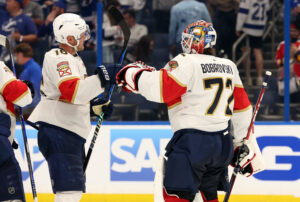The Toronto Maple Leafs are one of the National Hockey League’s all-time greatest franchises. The team has won Stanley Cups, iced Hall of Fame players, and created moments that have been cherished by fans of all ages. Recently, the franchise is having a coming back to life party after being mediocre for a very long time. That has revitalized the franchise and fans are starting to believe again. Although the franchise has had a rich history and is starting to regain its mojo, it still has its demons. Demons that a businessman like Ottawa Senators owner Eugene Melnyk can learn from.
Lessons Eugene Melnyk Can Learn From Harold Ballard
Former Leafs owner Harold Ballard was an interesting businessman. In The Game, Ken Dryden‘s book, Dryden wrote that Ballard seemed “like [a] wrestling villain who touches the audience to make his next villainy seem worse.”
Ballard said in his book that he once tore down a picture of Queen Victoria in the Maple Leaf Gardens because “she never gave him anything”. Ballard ruled with an iron fist. He enforced his will whenever possible. Ballard was feisty to the core and everyone hated him for that. Since he owned Maple Leaf Gardens and the team for the longest time, he got to call all the shots. For many Leaf fans, the idea of that was a flat out very scary thing, because Ballard was so unpredictable. The worst thing was that Ballard had no one to keep him in check. He called players out at will, made rash business decisions, and pissed off fans without putting much effort into it. At heart, Ballard wanted the team to win, but he lacked the intellect and the know-how to build a winner. Every time someone came along with the know-how to build a winner, Ballard flushed the sound mind out the door like he was a virgin at 24.
Ballard’s Mistakes
Harold Ballard’s biggest mistakes were driving the team’s best players and fan favourites out of town. Ballard’s legacy may as well be remembered for such foolish as those. Many of the bright hockey minds of today contribute Ballard’s rashnesses as being one of the reasons star players did not want to play for the Leafs during the 1970s and the 1980s. Which makes sense after Ballard’s treatment of star players like Bernie Parent, Dave Keon, and Darryl Sittler.
The Story With Darryl Sittler
As many Leafs fans know, Darryl Sittler was one of the best players to ever put on a Maple Leafs jersey. Sittler set a record which still stands today for most points in an NHL game He scored ten points (six goals and four assists) against the Boston Bruins. Sittler gave so much to the Maple Leafs franchise, but that did not stop Ballard from torturing Sittler before sending him into exile.
One could say, it was Punch Imlach who made a circus out of this situation, but one of the reasons Ballard hired the former-general manager back was that he was vehemently anti-union, and Sittler, among others, were getting a little too ingrained in the NHLPA for Ballard’s liking.
The first shot fired was by Imlach, who tried to block both Sittler and goaltender Mike Palmateer from appearing on Showdown, a program that ran during intermissions on CBC. That began a big feud with Sittler and other prominent players on the Leafs roster.
It got to the point that Imlach was willing to trade Sittler, the Maple Leafs best player, anywhere in the league. Unfortunately for him (and fortunately for Leafs fans), Sittler’s agent, Allen Eagleson, negotiated a no-trade clause into Sittler’s contract and said that it would only be waived for $500,000. Unfortunately for Leafs fans, Lanny McDonald did not have a no-trade clause, and since he was one of Sittler’s best friends on the team, Imlach decided to ship him out instead.
What Happened Next?
After the McDonald trade, Sittler ripped off his captain’s “C” in the dressing room, declaring that he could not be captain as he no longer could be a go-between the players and management.
By next season, with Imlach in the hospital after suffering his second heart attack, Ballard and Sittler made up publicly, and the “C” was back where it belonged. However, the détente would not last, and the relationship between the two men became so strained that Sittler would waive his no-trade clause without receiving compensation.
The Leafs traded Sittler to the Philadelphia Flyers for Rich Costello, a second-round pick, and future considerations, a package that amounted to almost nothing.
What Happened With Bernie Parent?
In short, the WHA was starting to gain its rise. Players were leaving the NHL for the rival league. Harold Ballard thought that the league was just a fad and did not worry about it too much. Since Ballard was not worried about the WHA, he left a lot of his players unprotected and unsigned. One of those players happened to be the 27-year-old Bernie Parent.
Parent signed with the Miami Screaming Eagles, who became the Philadelphia Blazers after initially failing to get off the ground. Parent lasted one year in the WHA before wishing to return to the NHL, but not to the Leafs
Ballard, perhaps still indifferent about Parent, approved a trade that sent the goalie from the Leafs (who still owned his NHL rights) to the Philadelphia Flyers. Parent immediately transformed into an all-world goalie, leading the league in wins, shutouts, and goals against average in back-to-back seasons, winning two Vezina awards and backstopping the Flyers to two consecutive Stanley Cups.
The Leafs got a first-hand look at how good Parent had become in 1975, as the Flyers swept the Leafs in the quarterfinal, an elimination act they repeated the next two years.
Can Ballard Spare Dave Keon?
Dave Keon was one of the most beloved and accomplished Leafs in franchise history. He helped the team win four Stanley Cups, including their last Cup in 1967, when Keon won the Conn Smythe trophy. He won the Calder trophy in 1960 and was ranked one of the top-100 players in NHL history by The Hockey News and the ranked as the best player to ever wear a Leafs jersey in their centennial year celebrations.
Ballard took over the Leafs in 1972 after a season in which captain Keon scored his lowest point total since his rookie season. The captain was accused of failing to provide the leadership necessary for the team by the ‘messed in the head’ owner, who refused to give the four-time Stanley Cup champion a pay raise. Keon eventually signed a three-year contract with the Leafs after a deal fell apart with the Ottawa Nationals of the WHA.
Keon had a strong 1972-73 campaign, in which he nearly matched career highs in goals and points. But by the time his contract was set to expire, Ballard was back in the media blasting his own captain. This time he vowed not to re-sign the popular forward and allowed Keon to sign with any other club. However, any club signing Keon would have to pay the Leafs compensation, and Ballard asked for so much that no NHL team signed Keon.
With the NHL no longer an option, Keon jumped to the WHA, three years later than he originally intended. He signed a two-year deal with the Minnesota Fighting Saints, but the team folded with 21 games left in the season. Keon intended to return to the NHL with the New York Islanders, a team on the cusp of becoming a dynasty, but Ballard once again blocked his return by demanding an unreasonable sum from the Islanders in compensation.
While Keon eventually returned to the NHL in 1979 as the NHL absorbed the Hartford Whalers, he never forgave Ballard or the Leafs for the terrible treatment he received and had a long-standing feud with the team.
What Can Eugene Melnyk Learn from Ballard?
Mr. Potato Head, also known as Eugene Melnyk, can learn so much from the Maple Leafs past owner. The main thing he can learn is something called the “Way Down The Line Effect” (WDTLE) and how his situation is a lot similar to that of hockey’s past Harold Ballard. The concept of the WDTLE is simple: nothing changes because it is all the same. The world one gets is the world one gives away. In Melnyk’s case, he does not share ties to Ballard, biologically speaking. Melnyk does, however, have the same mindset. At heart, Eugene is a penny pincher who would rather relocate the Senators franchise instead of spending the time and the money needed to get the Sens a downtown area. Not only is he making that mistake. Melnyk is playing a dangerous game of chicken with his franchise player Erik Karlsson.
Melnyk would rather trade the player that has elevated his team to new heights and help them make the playoffs. It is understandable. Melnyk may have money issues and he may not be able to afford to put out a team that could truly contend. Any hockey fan can understand that. The problem is this penny pincher wants to get rid of his best player because he does not want to pony up the money to sign him to a long-term extension. Something that Karlsson is deserving of. It is like déjà vu all over again. Instead, the idiot resigns in Northen Ontario and his star player wears a red jersey with an “O” on the front and a “C” to his side.
Ottawa is struggling to sell tickets as it is. If Melnyk wants to turn the Ottawa Senators to the Maple Leafs of the 1980s he sure is doing a good job at it. Forcing his GM to face situations that he should not have to face if Melnyk would back off, give him some cash to work with, and shut up. In all honesty, what Sens fan wants to support an owner who cares about making money and would relocate the team if that meant he could get some more money in his stockpiled bank account.
Point is; Ottawa needs to stop having parties with the “bad guy”. Some Sens fans may say it is not a party without him. He may even say that too, cheeko. But what Ottawa really needs to have is a party with the smart guy. That means Melnyk has to get that toothpick out of his mouth, rid himself of the “me first” attitude, and get his head out of his ass. In the short term, it may be expensive, but in the long term, it will be profitable.
Main photo:
Embed from Getty Images






